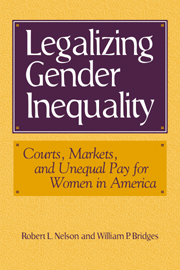Book contents
- Frontmatter
- Contents
- List of Figures and Tables
- Acknowledgments
- 1 Law, Markets, and the Institutional Construction of Gender Inequality in Pay
- Part I Theory and Method
- 2 Legal Theories of Sex-Based Pay Discrimination
- 3 Toward an Organizational Theory of Gender Inequality in Pay
- 4 Methodological Approach: Law Cases, Case Studies, and Critical Empiricism
- Part II The Case Studies
- Part III Conclusion: Legalizing Gender Inequality
- Appendix: Court Documents and Case Materials Used in Case Studies
- References
- Index
3 - Toward an Organizational Theory of Gender Inequality in Pay
Published online by Cambridge University Press: 07 August 2009
- Frontmatter
- Contents
- List of Figures and Tables
- Acknowledgments
- 1 Law, Markets, and the Institutional Construction of Gender Inequality in Pay
- Part I Theory and Method
- 2 Legal Theories of Sex-Based Pay Discrimination
- 3 Toward an Organizational Theory of Gender Inequality in Pay
- 4 Methodological Approach: Law Cases, Case Studies, and Critical Empiricism
- Part II The Case Studies
- Part III Conclusion: Legalizing Gender Inequality
- Appendix: Court Documents and Case Materials Used in Case Studies
- References
- Index
Summary
The influence of organizations on men's and women's wages is surrounded by practical and theoretical concerns. From a policy standpoint, whether anything needs to be done to redress earnings differences that exist inside organizations depends in part on the size and durability of the gender “wage gap” in society at large. If women's earnings are about to converge on those of their male counterparts, there is little practical benefit from understanding the nuances of where those wage differences came from. Indeed, even if the wage gap is significant and persistent, if existing market-based or cultural theories adequately explain the phenomenon, there would be little point in developing a new organization-level theory.
In this chapter we argue that neither is true. Despite some significant shrinking of the gender wage gap, substantial wage disparities continue, with no guarantee of a steady trend to wage parity. A significant portion of gender-based wage inequality exists between predominantly male and predominantly female jobs. And there are indications that organizations are the locus of a considerable segment of gender inequality in pay. We are warranted, therefore, in proposing a new organizational theory of gender-based wage inequality.
This chapter critically synthesizes the existing social scientific literature on the dimensions of and explanations for the earnings differences between men and women. It then proposes an organizational approach. In the first section we consider the size of the pay gap in both the United States and in other countries and how it has changed over time.
- Type
- Chapter
- Information
- Legalizing Gender InequalityCourts, Markets and Unequal Pay for Women in America, pp. 53 - 100Publisher: Cambridge University PressPrint publication year: 1999



